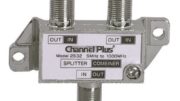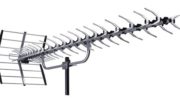We actually have a lot of data about the electrical properties of a massive chunk of copper, thanks to this lady. Although you’re extraordinarily unlikely to put a piece of copper 151 feet high up and use it as an antenna, you might wonder what would happen if you did.
Copper, you see, is a very good conductor of electricity. That’s why you see it in wires. It’s also relatively inexpensive in small quantities, unlike silver which is an even better conductor. Its softness helps wires bend and gives us the ability to create massive effigies of ladies which we choose to put in harbors if we want. But clearly it’s the wrong material for an antenna despite all of this, because if copper were the right choice for an antenna people would use it.
If you took a standard design for an antenna and lovingly reproduced it in copper, it would work great! It would give you much better reception than an antenna made out of aluminum, the standard choice for antennas. You’d be thrilled, and you might even like that nice color that copper has.
And then…
Because copper bends more than aluminum, you would find that the antenna’s elements bent more easily. This would make it less efficient. You could make a thicker antenna but of course that would be more expensive, and since copper is already more expensive than aluminum, pretty soon there would be a significant difference in the cost of your copper antenna. But hey, people pay for quality, right? So that’s not a problem.
No, the big problem is that copper oxidizes. Almost every metal does – mild electrical charges and the presence of water create an opportunity for the “naked” metal to join with oxygen to form a new compound. In the case of aluminum, the outside of the antenna may develop a black, powdery coating because of the presence of aluminum oxide. With your copper antenna it would start to turn green, like the lady in the harbor.
And frankly, friends, this is where it would all fall apart. Aluminum oxide is almost exactly as conductive as plain aluminum, and it forms a protective coating that doesn’t allow more aluminum to oxidize. So, that blackish antenna may look ugly but it’s actually lasting longer.
Copper oxide is much less conductive than bare copper, much less than aluminum and much less than almost anything else you can use for an antenna except plastic. It also doesn’t protect the copper under it and breaks easily. A copper antenna would corrode quickly into an unstable mess that would snap off in a stiff breeze, but it would probably stop working long before that.
Now, if you really did want a copper antenna, I suppose you could build it strong and then laminate it with some sort of plastic or polyurethane coating. This would slow the process of oxidation down to the point where you could use the antenna for several years happily. But then, you’re talking about a much more expensive, much heavier antenna and it’s just cheaper and easier to use an aluminum one which will probably work well enough.
Remember at the end, with digital signals…if you get the signal you get it. There’s no benefit to a much stronger signal once the signal is strong enough that it’s received easily in all weather conditions, and an amplifier can be used to compensate for long cable runs much more efficiently than a larger copper antenna can.
So, folks, I guess the dream of a copper antenna is dead. Not that it was truly ever alive, but it was fun to talk about for a little while.





